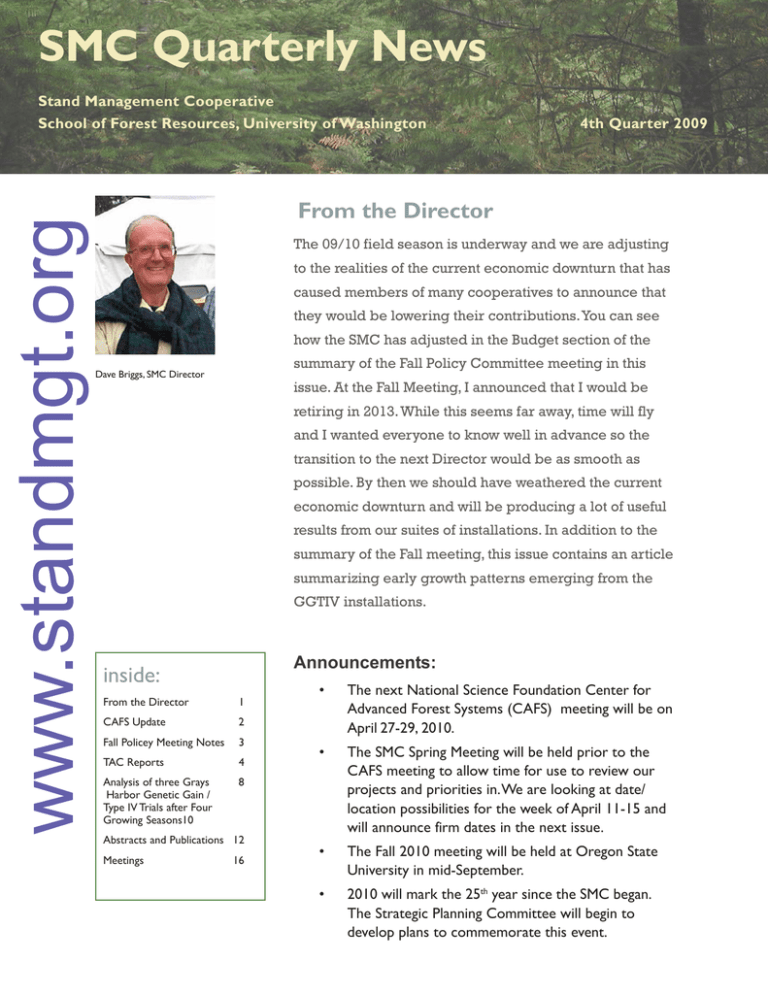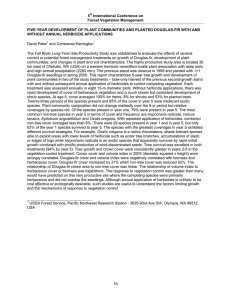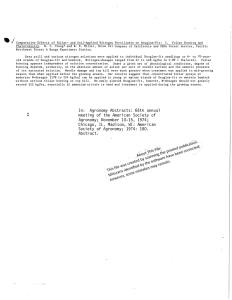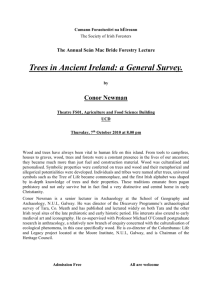SMC Quarterly News From the Director
advertisement

SMC Quarterly News www.standmgt.org Stand Management Cooperative School of Forest Resources, University of Washington 4th Quarter 2009 From the Director The 09/10 field season is underway and we are adjusting to the realities of the current economic downturn that has caused members of many cooperatives to announce that they would be lowering their contributions. You can see how the SMC has adjusted in the Budget section of the summary of the Fall Policy Committee meeting in this Dave Briggs, SMC Director issue. At the Fall Meeting, I announced that I would be retiring in 2013. While this seems far away, time will fly and I wanted everyone to know well in advance so the transition to the next Director would be as smooth as possible. By then we should have weathered the current economic downturn and will be producing a lot of useful results from our suites of installations. In addition to the summary of the Fall meeting, this issue contains an article summarizing early growth patterns emerging from the GGTIV installations. Announcements: inside: From the Director 1 CAFS Update 2 Fall Policey Meeting Notes 3 TAC Reports 4 Analysis of three Grays Harbor Genetic Gain / Type IV Trials after Four Growing Seasons10 8 Abstracts and Publications 12 Meetings 16 • The next National Science Foundation Center for Advanced Forest Systems (CAFS) meeting will be on April 27-29, 2010. • The SMC Spring Meeting will be held prior to the CAFS meeting to allow time for use to review our projects and priorities in. We are looking at date/ location possibilities for the week of April 11-15 and will announce firm dates in the next issue. • The Fall 2010 meeting will be held at Oregon State University in mid-September. • 2010 will mark the 25th year since the SMC began. The Strategic Planning Committee will begin to develop plans to commemorate this event. National Science Foundation Center for Advanced Forest Systems (CAFS) Grant The UW proposal to join CAFS was accepted in February 2009. We received $70,000 for 2009 which was allocated to three projects (1) $20,000 additional support for environmental monitoring of the Type V (paired-tree fertilization) installations, (2) $20,000 support of basic research on use of terrestrial LiDAR to measure tree and crown characteristics and response to treatments, and (3) $18,000 for further development of non-destructive techniques to measure and model wood density which is important for estimating dry weight, carbon, and energy content of trees. An application for a $7600 supplement for undergraduate research was also successful; it is being used with the terrestrial LiDAR project. The balance of the $70,000 reflects indirect, administrative and travel costs to the CAFS annual meeting. We have just received $70,000 for 2010 and as long as UW receives more than $300,000 in a year from its industry supporters, will receive $70,000 in 2011, 2012, and 2013. Summer Field Work SMC staff Bob Gonyea, Bert Hasselberg, and Randy Collier and a summer field crew consisting of graduate students Paul Footen, Kim Littke, Carol Shilling, and Gonzalo Thienel and undergraduate Ryan Reith accomplished the following • Paired-tree fertilization (Type V) installations: Kim, Bob and Bert established 27 new installations, bringing the total to 62. These all have soil pits, lysimeters, and temperature and precipitation gauges. Additional installations are being sought to fill gaps in coverage. Two undergraduate students assisted Kim with her fieldwork, Jennifer Perkins and Malloree Weinheimer. • GGTIV installations: The remainder of the summer crew collected competing vegetation and habitat data on the three GGTIV (geneticgain-Type IV) installations planted in 2005. These three installations now have tree and competing vegetation data after the 2nd and 4th growing seasons. All GGTIV installations now have the same environmental sensors that are in the Type V installations. • The summer field crew also completed vegetation and habitat assessments on 3 installations (21 plots), soil sampling (3 installations), and pitch moth surveys (11 plots). Salaries and expenses for the summer field crew students were paid by UW funds, primarily the Corkery Family Chair, some of the staff time was paid through the NSF CAFS grant, and expenses for instrumentation were paid by AGENDA 2020 and CAFS funds. 2 Fall Policy Committee Meeting The fall SMC Policy Committee meeting was held at the Little Creek Casino Resort, Kamilche, WA, on September 22-23 with 41 attendees from 23 organizations. Full minutes of the meeting are available at www.standmgt.org. A few highlights Membership: Forest Systems sold its lands and is no longer a member. Stimson Lumber Co., Forest Grove, OR became a member. Students: One graduate student graduated and 9 graduate students are in residence. All are funded by external grants and UW Gessel Scholarships, the Corkery Family Chair, and teaching assistantships. Tech Transfer: 4 articles in print, 2 accepted, 10 in review. Lists of these articles can be found in the minutes on the SMC website. Policy Committee Chair and Vice Chair: The Fall 2009 meeting marked the end of the 2 year term of Louise de Montigny (BC Ministry of Forests Research Branch) as Chair of the Policy Committee. Vice-Chair Dave Rumker (The Campbell Group), takes over as Chair and Jeff Madsen (Port Blakely Tree Farms) was elected as the new Vice Chair. Budget: At the Spring Meeting it became apparent that two factors, a history of flat dues coupled with inflation and the current economic crisis, were creating a budget future with deficits that needed to be addressed. In fact, some members announced that they would be reducing contributions to cooperatives in 2010. A Finance Committee was formed to investigate and recommend solutions. First, the following actions were implemented in July 1. We laid off one of our two database management staff. 2. Summer salaries for the Director and the Nutrition and Silviculture Project Leaders were reduced. 3. Salaries for the remaining staff were reduced by 7.7%. 4. We curtailed all other expenditures as much as possible. In addition to the layoff of one person, these actions effectively meant a 2week shut down for all personnel during the last half of 2009. These actions eliminated the projected 2009 deficit and create a balance to buffer the economic uncertainties affecting member dues in 2010. Analysis of several dues reduction scenarios for 2010 were examined and presented at the Policy Committee meeting. The Policy Committee approved a motion to reduce dues by 20% for 2010 only, We will closely monitor the situation as 2010 develops and re-examine the dues for 2011 at the Fall 2010 Policy Committee Meeting. 3 Other Funding: The CAFS grant from NSF will provide $70,000/year for 2009-2013, UW support for graduate students and the summer field crew totaled $148,000. The BC Ministry of Forests obtained a $70,000 grant to support measurement of SMC installations in BC. NCASI provided $40,000 to support continued work at Fall River, Matlock, and Molalla and it is expected that NCASI will provide $30-40000 in 2010. Strategic Plan. The following projects were previously identified as high priorities under the current strategic plan 1. A model validation study: a joint effort of the Modeling and Silvicuture TAC’s. 2. An analysis of performance of the Type I, II, and III installations in a “LOGS” style report: Silviculture TAC. 3. Development of criteria for “retirement” of SMC installations: Silviculture TAC as lead. 4. Create the paired-tree fertilization trials: Nutrition, Silviculture, and Wood Quality TAC’s. We have made substantial progress on the paired-tree fertilization (Type V installation) study. Plans for 1-3 have been made by the TAC’s but no progress has occurred due to budget limitations. Modeling Project Report: Project Leader Dave Marshall reviewed updates on FVS, ORGANON and Conifers which have the following links FVS http://www.fs.fed.us/fmsc/ ORGANON http://www.cof.orst.edu/cof/fr/research/organon/ CONIFERS http://www.fs.fed.us/psw/programs/ ecology_of_western_forests/projects/conifers/ Dave reviewed the status of red alder plantation modeling for which the SMC built the database. A version for FVS has been completed. For the ORGANON version, most of the equations have been completed and the remainder are under development and should be completed soon. Dave also reviewed the current Modeling Project Priorities. One, development of genetic modifiers in ORGANON has been completed, The remaining top priority group includes completing the red alder analysis, the ongoing collaboration with CIPS on a process model proposal, and growth model evaluation (Strategic Plan item 1 noted above). The second group includes work with the wood quality TAC on wood quality model4 ing and updating thinning and fertilization analyses. The third group includes developing funding opportunities in biofuel and biomass modeling and in climate and weather modeling. Nutrition Project Report: Project leader Rob Harrison summarized current projects. Carryover Study: MS student Paul Footen found small but statistically significant differences in mean DBH and height after about the 5th year since planting as well as understory differences. He is completing understory/site characterization work, and has a manuscript accepted for North American Forest Soils conference. Fall River/Matlock/Molalla LTSPs: $40,000 was received in 2009, bringing the cumulative total to $555,000 with $30-40,000 new NCASI funding likely for 2010. Former PhD Brian Strahm, now professor at Virginia Tech, wrote 2 publications. New PhD student Carol Shilling, is nearing completion of 5-year aboveground biomass and some root work at the Matlock and Molalla LTSPs. Effects of urea fertilization on carbon sequestration in Douglas-fir plantations of the Pacific Northwest: Masters student Ben Shyrock is completing his thesis on this study. Paired Tree Fertilization: PhD student Kim Littke is working on this project and we presently have 62 installations. Of these, the first six, established and fertilized in 2007 will be re-measured for the first time in the upcoming field season. Rob noted that Paul Footen will start on a PhD after completing his Masters and that a new student Joy Liu from Taiwan will be entering this Fall. Silviculture Project Report: Project Leader Eric Turnblom reviewed the plan for field work in the 09/10 field season and the following projects. GGTIV Installations: Maintenance activities in 2009 included repairing fence, remonumenting plot corners, and vegetation control to the 80% bare ground specification on relevant plots at all six installations. The 2005 plantations now have full measurements, summer vegetation surveys and habitat characterization (duff depth, vertical porosity, etc.) after the 4th growing season. Type III Mixed Species installations These pure and 50-50 mixtures of Douglasfir and Western hemlock in alternating rows with two replicates. Mariano Amoroso analyzed the age 12 data for his MS thesis; an age 18 analysis is underway. 5 Criteria for retiring installations: One of the strategic plan priorities, ideas that have been proposed were reviewed and will be discussed at a TAC meeting to be scheduled later this Fall. Vegetation Composition and Succession in Managed, Coastal Douglas-fir Ecosystems PhD student Kevin Ceder is working on this NCASI sponsored project. The objectives are (1) to develop overstory / understory relationships in young, managed Douglas-fir stands at the species level as affected by initial spacing and thinning, (2) to benchmark the developed relationships against a small, independent data set, and (3) to test the extrapolative power of the models by comparing to observed data from differently treated stands (thinned and pruned) not used in model building. Sun-Tree Identification in Tree Lists of Multi-Strata Stands: PhD student Nick Vaughn is working on this project sponsored by the USFS and cooperating with OESF / ONRC. It is examining the conjecture that the top level or uppermost canopy stratum may “drive” size / density relationships, hence stand dynamics. Wood Quality Project Report: Project Leader Eini Lowell summarized progress on the following projects Determining the effect of thinning, site quality and stand density on wood quality using non-destructive testing to develop predictive models (stiffness, wood density, dry weight-biomass, carbon, energy). This project is a collaboration of the PNW Research Station, Canadian Forest Service Wood Fibre Centre, and the SMC. It will use four of the Levels of Growing Stock (LOGS) installations and sample 135 trees/installation from 3 treatments (thinning regimes and control); 3 plots per treatment; 15 trees per plot. Each tree will be measured with the ST300 acoustic tool (related to stiffness) and Resistograph (related to density), Increment cores for x-ray densitometry from will be obtained from a sub-sample of trees to calibrate Resistograph readings and build wood density models. SMC/CIPS Paired-Tree Fertilization Projects: Plans have been made to determine how key measures of wood quality are affected by site factors, stand conditions, management practices, and genetics. This includes using nondestructive testing for stiffness and wood density on the stems of the plot center trees and using terrestrial lidar to estimate changes in branches. Stem form, and leaf area index. The terrestrial lidar research is being done by PhD student Guang Zheng under the supervision of Prof. Monika Moskal with the Precision Forestry Cooperative. 6 Non-destructive evaluation of wood quality in standing Douglas-fir trees and logs: This project sampled trees from four Type II installations to develop relationships between tree acoustic velocity, log acoustic velocity and stiffness of recovered lumber and veneer. An integrated and edited database of this project, funded by AGENDA 2020, is expected to be finished at end of 2009 to facilitate several analyses. X-ray densitometer data from ends of each log, received from Weyerhaeuser is being analyzed by PhD student Rapeepan Kantavichai. She is developing pith to bark density models using tree, stand, treatment, soil, and climate data from the different installation sites.. Veneer modeling continues in cooperation with Christine Todoroki, Scion, New Zealand. Note: The TAC’s are planning to schedule meetings later this year. If you would like to participate, contact the appropriate project leader to ensure that you are on their contact list. Dave Marshall: David.Marshall2@weyerhaeuser.com Eini Lowell: elowell@fs.fed.us Rob Harrison: robh@u.washington.edu Eric Trunblom: ect@u.washington.edu 7 Analysis of three Grays Harbor Genetic Gain / Type IV Trials after Four Growing Seasons (5 yr. from seed) Keith Jayawickrama, Brad St. Clair, Eric Turnblom, and Terrance Ye Introduction The principal objectives of this series of trials were (1) to understand the long-term effects on productivity, quality, and diversity of Douglas-fir trees and stands when the latest advances in genetics, seedling culture, and early vegetation management are deployed in combination; (2) to compare the growth and yield of genetically selected trees to unselected woods-run trees, per unit area basis; (3) to compare the predicted genetic gains derived from progeny tests (individual tree basis) with realized gains in independent block plot trials (unit area basis); (4) to provide data to modify / update growth models for effects caused by genetic selection, intensive weed control and different spacing. The trials include six sites, with three sites established in 2005 and three more in 2006. In 2009, data were collected for the second time (using a two-year interval) at the three 2005-installation sites after four seasons in the ground. Treatments and Data Collection Three factors are being studied in this series of trials: i) genetic gain (three levels), ii) tree spacing (three levels), and iii) vegetation control (two levels), which, in combination with each other define the treatments. The genetic gain (G) factor levels are defined as follows: (G1) Base population (random sample of 50 wild trees distributed throughout the Grays Harbor breeding zone). (G2) Intermediate population (a mix of pair crosses among 20 parent trees chosen to represent an intermediate level of genetic gain). (G3) Elite population (a mix of crosses among clones of the 20 best parent trees in each breeding unit designed to represent a high level of genetic gain). (G3) Elite population (a mix of crosses among clones of the 20 best parent trees in each breeding unit designed to represent a high level of genetic gain) The spacing (S) factor levels are defined as follows: (S1) 15 × 15’ spacing or 200 Stems Per Acre (SPA), i.e. low density (S2) 10 x 10’ spacing or 440 SPA, i.e. intermediate density (S3) 7 × 7’ spacing, or 889 SPA, i.e. high density 8 Donkey Creek after growing season #5 The vegetation control (V) levels are defined as follows: (V1) Standard (operational), i.e. one tank mixed herbicide application at time of site preparation (V2) Complete, i.e., maintaining 80% or better bare ground for four consecutive growing seasons There are 22 plots at each of six sites, but only the three sites planted in 2005 were measured in 2009. Plot size varies with spacing such that there are 64, 100, and 250 trees available for measurement in the low, intermediate, and high-density spacings, respectively. Measurements collected on the individual trees included basal diameter on every tree, DBH on every tree tall enough to have it, total height on every tree, crown width in two directions perpendicular to each other on a 42-tree sub-sample of each plot, and comments where warranted (dead, browsed, etc.). A total of 6,314 trees were measured. Data analyses For the purposes of this intermediate analysis of only three installations, the experimental design was treated as if it were completely randomized. Although analyses were conducted at plot level for each site separately and for all sites combined, and at the individual tree level for all plots combined to compare realized gains at the full-sib family level, focus here is placed on the plot level analysis across all sites. (The results of the other two analyses have been reported elsewhere). So, assuming a completely randomized design for the multiple-site plot level analysis, the following linear model was used for conducting the Analysis of Variance: yijkl sitei gen j veg k denl ( site gen)ij ( site veg )ik ( site den)il ( gen veg ) jk ( gen den) jl (veg den) kj ( site gen veg )ijk ( site gen den)ijl ( site veg den )ikl ijkl where yijkl is the plot mean of height, dbh, or plot survival rate for the ith site, jth seedlot, kth vegetation control, and lth density. All model terms were considered as fixed except for the random error ( ijkl ). Each site was assumed to have a unique error variance to improve the fit of the models. Trees that had not yet reached breast height were considered to be missing values. Statistical significances were tested for all fixed effects, as well as for two contrasts to comparing genetic gain levels. Realized gains for the two genetically improved seedlots were estimated with the formula: ÄG(intermediate) = (G2 - G1) × 100 / G1 and ÄG(elite) = (G3 - G1) × 100 / G1. 9 Results Strong evidence (p < 0.001) was observed pointing to differences among test sites for both height and dbh as well as for survival at total age 5. In general, with respect to these stand attributes, site productivity follows the pattern: 601 (Donkey Creek 2) > 603 (Donaldson Creek) > 602 (Crane Creek 2). Ranked observed total heights by site were 7.5, 6.3, and 5.4 ft for 601, 602, and 603, respectively. Observed site average DBHs were 0.73, 0.56, and 0.45 for 601, 602, and 603, respectively. Survival averaged 90%, 86%, and 79% for 601, 602, and 603, respectively. According to the across-site plot level analysis, the genetically-improved seedlots grew significantly better than the unimproved seedlot for both height and dbh (see Figures 1, 2). No significant difference was found between the elite and the intermediate seedlots. Realized gains were higher for dbh (11.2% for the elite, 12.5% for the intermediate) than for height (7.9% for the elite, 6.5% for the intermediate). Figure 1. Mean DBH of Douglas-fir in Grays Harbor Genetic Gain / Type IV trials after four growing seasons as affected by spacing and genetic gain level. The trees planted at the 7 x 7 ft and the 10 x 10 ft were taller than that from the 15 x 15 ft plots, although the difference was only marginally significant (P=0.08). Though not statistically significant, there was a general upward trend in DBH, as well. These density effects have been fairly well documented for Douglas-fir plantations aged 7 to 9 years. No meaningful, nor statistically significant effect of vegetation control on DBH or height was observed. Survival rate was similar among genetic gain levels at total age 5. There were significant differences between densities for survival. Complete vegetation control seemed to have boosted survival somewhat, though the evidence is only marginal (p = 0.052, Figure 3). Figure 2. Average total height of Douglas-fir in Grays Harbor Genetic Gain / Type IV trials after four growing seasons as affected by spacing and genetic gain level. Though the analysis is not shown here, the correlation of estimated realized gains for height between age 3 and 5 was about 0.7, based on the data from these three 2005-installation sites. Figure 3. Survival (%) of Douglas-fir in Grays Harbor Genetic Gain / Type IV trial after four growing seasons as affected by spacing and vegetation control level. 10 Discussion / Summary The results reported here should be considered preliminary, as they involve only the three sites planted in 2005. Strong evidence was observed for site effects: 601 > 603 > 602. Solid evidence was observed that genetic gain level affected average total height and mean DBH at total age 5, though the effects may be slightly exaggerated due to the exclusion of trees shorter than 4.5 ft (breast height) in the analyses. However, at least half of all trees on very plot were taller than breast height, with 85% of all trees exceeding breast height on average across all plots / sites. Evidence was also observed to indicate better survival on denser plots and on weed free plots. The lack of significance between the elite and intermediate populations, and in seedlot ´ density and seedlot ´ vegetation interactions may have been due to weak inter-tree competition at total age 5. There is expectation that the differences observed to date will likely increase as trees age and grow larger. Other differences too small to detect at this early age may also become evident. 11 Abstracts and Publications Stoehr, M.U.; Ukrainetz, N.K.; Hayton, L.K.;Yanchuk, A.D. Current and future trends in juvenile wood density for coastal Douglas-fir. Canadian Journal of Forest Research, Volume 39, Number 7, 7 July 2009 , pp. 1415-1419(5). Abstract Increment cores from 10 full-sib families in each of three planting series were collected on 22 test sites per series (a total of 7063 samples across 63 sites). Juvenile wood density for individual test sites ranged from 0.378 to 0.481. Stepwise multiple linear regression analysis with wood density as the dependent variable and a battery of annual and monthly climate variables as independent variables was used to model the current distribution of wood density across the landscape in coastal British Columbia. Differences in the average temperature between the coldest month and the warmest month, precipitation in July, and the mean annual precipitation were the only significant variables predicting wood density, accounting for 47% of the total variation across all sites. Using two future climate change models (CGCM2 A2x and HADCM3 A2x) to predict changes in the three climate variables, wood density was mapped. Wood density will be reduced generally in the present range of coastal Douglas-fir (Pseudotsuga menziesii (Mirb.) Franco var. menziesii), especially on southern Vancouver Island and along the coastlines of southern British Columbia. This may have implications for the future utility of Douglas-fir as a structural wood species, as well as for breeding and deployment. 12 12 Abstracts and Publications cont. Erickson, Heather E.; Harrington, Constance A.; Marshall, David D. Tree growth at stand and individual scales in two dual-species mixture experiments in southern Washington State, USA. Canadian Journal of Forest Research, Volume 39, Number 6, 1 June 2009 , pp. 1119-1132(14). Abstract Planting with mixtures of tree species rather than single species is often considered during reforestation because of the potential increased productivity and other benefits. We examined tree growth at the stand and individual tree scales in two experiments contrasting monocultures with a 1:1 mixture of tree species: (1) Douglas-fir (Pseudotsuga menziesii (Mirb.) Franco) with a conifer of similar shade tolerance (western white pine (Pinus monticola Dougl. ex D. Don)) and (2) Douglas-fir with a more shade-tolerant conifer (western hemlock (Tsuga heterophylla (Raf.) Sarg.)). There was no effect of mixture on growth or yield in the Douglas-firwestern white pine combination. In the Douglas-fir- western hemlock combination, yields in the mixture equaled those in Douglas-fir stands because of the enhanced performance of Douglas-fir in the mixture. For Douglas-fir, the height/diameter (h/d) ratio was significantly less in mixture, suggesting reduced competition for light when grown with western hemlock. In contrast, the h/d ratio for western hemlock was significantly greater in mixture, suggesting increased competition for light when grown with Douglas-fir. Neighborhood analyses showed that tree growth was directly related to initial size and inversely related to relative neighbor size and that the h/d ratio was positively related to relative neighbor size. In general, the size of a neighboring tree influenced growth more than species identity. Relationships between h/d ratios and growth rates suggest that growth differences between Douglas-fir and western hemlock in mixture will eventually increase. 13 13 Abstracts and Publications cont. Maguire, Douglas A.; Mainwaring, Douglas B.; Rose, Robin; Garber, Sean M.; Dinger, Eric J. Response of coastal Douglas-fir and competing vegetation to repeated and delayed weed control treatments during early plantation development. Canadian Journal of Forest Research, Volume 39, Number 6, 1 June 2009 , pp. 1208-1219(12). Abstract A key silvicultural decision in managing young conifer plantations is determining the number and timing of release treatments to control competing vegetation. Three coastal Douglas-fir (Pseudotsuga menziesii (Mirb.) Franco) plantations were treated under eight alternative herbicide regimes during the first 5 years after planting to test treatment effects on vegetation dynamics and seedling growth. After termination of herbicide treatments, competing vegetation developed at a rate similar to that of check plots, reaching 40%-60% cover in the first growing season and approaching 100% by the third. Recovery of competing vegetation was slightly more rapid with greater number of previous releases. Annual volume growth of seedlings was negatively correlated with current cover of competing vegetation, but competitive effects from previous years were fully accounted for by initial tree size. Under 4 years of release, delaying treatment by 1 year reduced volume attained at the end of 5 years by about 15%. Plots receiving 5 consecutive years of weed control reached the 5year volume of check plots in only 3.9years, implying an age shift of 1.1years. Increasing the number of operational release treatments significantly improved seedling growth in the short term, but long-term growth effects must be monitored to determine the economically optimal regime. 14 14 Abstracts and Publications cont. Hawkins, B. J.; Stoehr, M.. Growth, phenology, and cold hardiness of 32 Douglas-fir full-sib families. Canadian Journal of Forest Research, Volume 39, Number 10, 1 October 2009 , pp. 18211834(14) Abstract Thirty-two full-sib families of coastal Douglas-fir (Pseudotsuga menziesii (Mirb.) Franco var. menziesii) with a range of predicted breeding values were monitored for growth rate, phenology, and cold hardiness over 2 years on two sites to investigate if other traits are being selected when family selection is based on height. Significant differences among families existed in most phenological, growth, and cold-hardiness traits. On average, taller families burst bud later but did not have significantly different growth rates or length of growing period than other families. We found no significant correlations between family date of bud burst and cold hardiness in late spring or between duration of shoot growth or height and autumn freezing damage. Family differences in freezing tolerance were greatest in September and October. In these months, family current-year leaf nitrogen was positively correlated with cold hardiness. Families that were most hardy in the autumn were not the most hardy families in spring. We conclude that, for the studied breeding series, selection based on height does not have a significant impact on cold hardiness. We found no consistent relationships between phenological, growth, or cold-hardiness parameters and final height that could explain family ranking by height. Relationships between grandparent elevation and dates of bud burst and cold hardiness were observed. 15 Upcoming Meetings and Events December 2,3, 2009, Forest Health: Identification and management of forest insects & diseases. Holiday Inn,Wilsonville, OR. http://www.westernforestry.org. December 10, 2009, Managing Forestlands for Biomass Utilization Holiday Inn Eugene, Springfield, OR. http://www.westernforestry.org. Janurary 12-14, 2010. Restoration of Disturbed Sites with Native Plants: An Integrated Approach. Penguin Student Union at Clark College Vancouver, WA. http://www.westernforestry.org Stand Management Cooperative, School of Forest Resources University of Washington, Box 352100 Seattle, WA 98195 16




